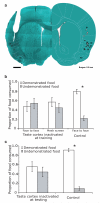State dependence of olfactory perception as a function of taste cortical inactivation
- PMID: 20023656
- PMCID: PMC2834247
- DOI: 10.1038/nn.2463
State dependence of olfactory perception as a function of taste cortical inactivation
Abstract
As anyone who has suffered through a head cold knows, food eaten when the olfactory system is impaired tastes 'wrong', an experience that leads many to conclude that taste stimuli are processed normally only when the olfactory system is unimpaired. Evidence that the taste system influences olfactory perception, however, has been vanishingly rare. We found just such an influence; if taste cortex was inactivated when an odor was first presented, later presentations were properly appreciated only if taste cortex was again inactivated.
Figures



Comment in
-
Multisensory integration: an inner tongue puts an outer nose in context.Nat Neurosci. 2010 Feb;13(2):148-9. doi: 10.1038/nn0210-148. Nat Neurosci. 2010. PMID: 20104206 No abstract available.
References
MeSH terms
Substances
Grants and funding
LinkOut - more resources
Full Text Sources
Medical
Research Materials

